Controversial ads can be a success. After all, sometimes a little controversy can be a good thing. People do say “There’s no such thing as bad publicity”.
But if you’re a marketer looking to introduce a little controversy into your latest campaign, remember that there’s a fine line between the worst and best ad campaigns in history.
Only the worst and most controversial ads have made this list. These massive advertising fails got us thinking about how these ads even qualified for a wider audience… we are looking at you World Wildlife Fund!
Thankfully the failures of others can become a learning opportunity for your future advertising.
We can all learn from these controversial ads – what common problems do these ads share? and how can your next ad campaign avoid making our next list of bad ads?
Table of Contents
1. Controversial ads of Dove – Real Beauty Campaign
- Year: 2004
- Media: Television, Print, Experiments
Yes, that’s right, the same ad campaign that made it on the Best Ad Campaigns is also listed here.
When you are running a campaign that spans 16 years, you are bound to make some mistakes on the way. Especially when your focus topic is a social issue.
However this campaign earned Dove the racist ads red card.
In 2017, Dove delivered this advertisement, demonstrating that a black woman could become white by using their products…
If the goal was to take us back one hundred years, they successfully achieved it!
Why is Dove on the list of controversial ads?
It has an obvious, although according to Dove unintentional, racist message.
What made this especially bad for Dove was that a similar controversy occurred in 2011 including more racist ads in the Real Beauty Campaign.
C’mon people, learn from your mistakes!
Takeaways from Dove’s bad advertisement
Pay attention to symbolism in your videos, words, and imagery. Even a positive message like beauty equality can get buried under bad press if your message is not on point.
If you are unsure whether your ad has problematic undertones, it may be worthwhile hiring a diversity consultant to ensure that you are not unintentionally offending people.
People remember these types of mistakes, and they can do lasting damage to your brand.
2. Procter & Gamble Sexist Ads – Mother’s Day Campaign
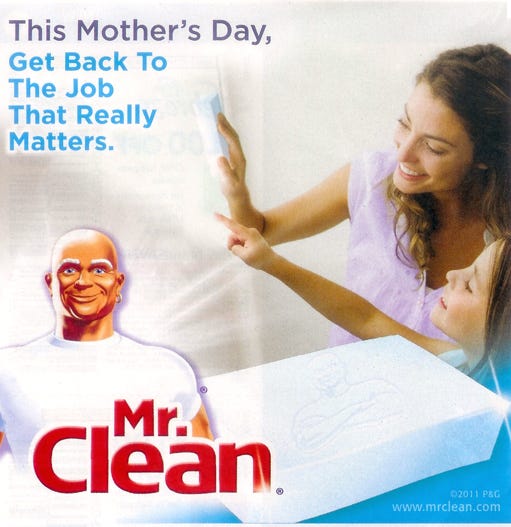
- Year: 2011
- Media: Print
Procter & Gamble present: Shameless Sexist ads.
Why not celebrate Mother’s day with a friendly sexist reminder that cleaning is a woman’s job?
P&G’s brand, Mr. Clean, delivered an ad of a smiling mother and daughter cleaning a surface with the slogan “This Mother’s Day, get back to the job that really matters.”
The ad was just plain confusing: what exactly was P&G trying to imply here? That teaching your daughter her place in society (cleaning up after a man) is the most important job a woman has?
They tried to amend this message with a new ad, featuring the tagline “You gotta love a man who cleans.”
…throw in another gender stereotype! Solid effort guys, especially when the media should be lifting women up, not holding them down.
Why is it connected to Sexist Ads?
The assumption in both ads is that women do the cleaning, and should be happy if a man lifts a finger. The use of gender stereotypes conveyed a sexist message, which is damaging for any brand.
However, the sexism of the ad seemed a strange choice for P&G – if you believe women should do the cleaning, then surely they are also your target customer? So why would you try to alienate them with sexism?
Do better P&G!
Takeaways from P&G’s Bad Advertisement
Don’t be sexist! If you are creating original content for an ad campaign, proofread your content and consider what message you’re sending out before clicking ‘Publish’.
If you’re unsure, connecting with your target audience might be a good idea. Focus groups are a great way to trial an ad campaign before releasing them to the unforgiving media market.
3. Bloomingdales Sexist Ads – Christmas Catalogue
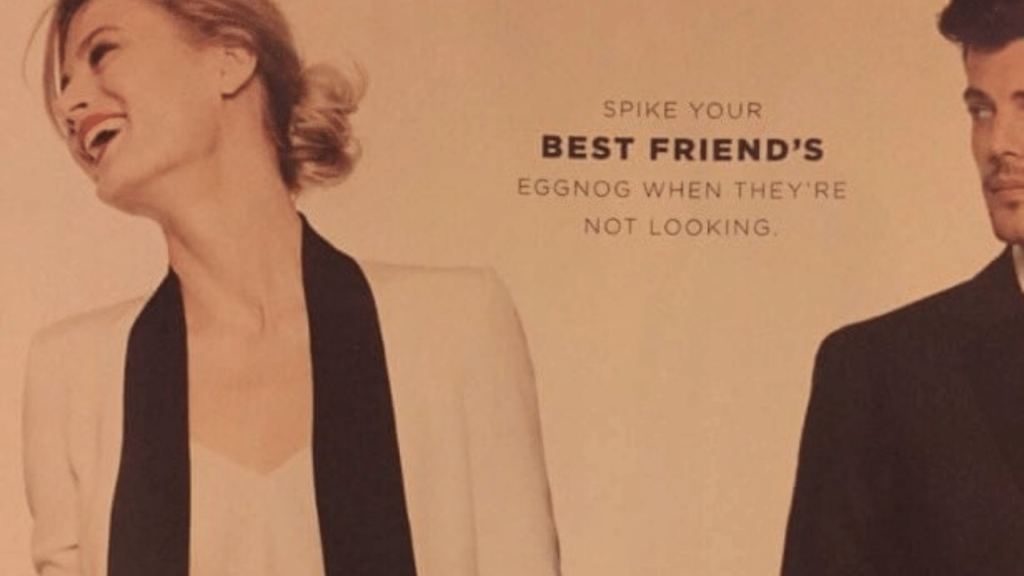
- Year: 2015
- Media: Print
In 2015, the geniuses at Bloomingdales decided to sprinkle their Christmas catalogue with some festive date rape jokes.
Earning them a solid place in the sexist ads hall of fame.
The print ad that read ‘Spike your best friend’s eggnog when they’re not looking’ was instantly condemned and people on social media did not hold back.
The holiday season turned into a PR disaster for the department store, who published an apology in response.
Not revealing who the brain behind the operation was, nor admitting or denying if too much holiday eggnog led to this disaster.
In the words of Ice Cube – “check yo self before you wreck yo self”, Bloomingdales!

How did Bloomingdales land on the list of sexist ads?
A distasteful use of inappropriate humor to sell their product range was just insulting.
Bloomingdales was a brand with a solid and long-standing reputation. Why did they decide to throw it away over such a small detail?
Takeaways from Bloomingdale’s Bad Ads
Again, take a good look at your content people! The lack of attention to detail is what sunk this campaign. Anyone taking a second look over this message could have spotted the problem.
Bloomingdales failed to understand the importance of messaging. Ask yourself, what is the message I am putting out there? Is this appropriate? Do I want to associate this with my brand?
4. Controversial Ads from WWF – the Tsunami Relief Campaign
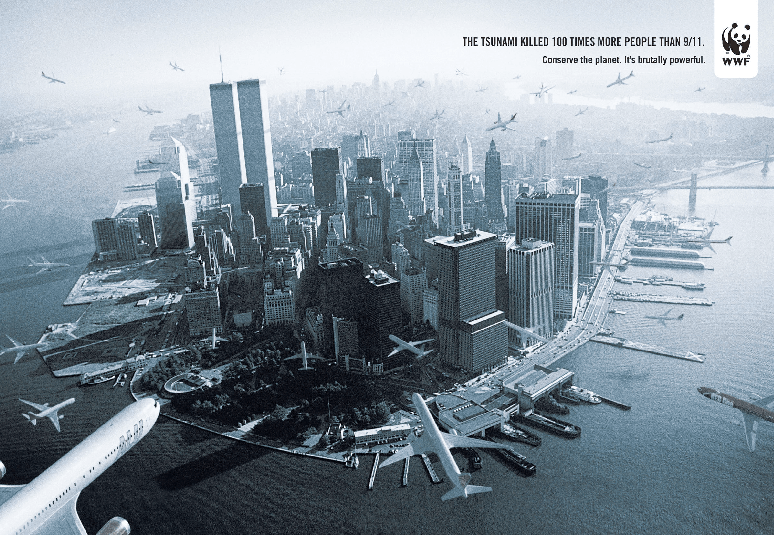
- Year: 2008
- Media: Print, Video
This one might be the #1 on our list of controversial ads. No one likes the person that always tries to “one-up” people’s stories, “you think you have it bad? When I was…”
The World Wildlife Fund managed to incorporate this attitude (but on steroids) into their marketing campaign, “Tsunami”
To bring awareness to the destruction and number of lives lost in the 2004 Indian Ocean Tsunami, the WWF used an image of airplanes crashing into NY skyscrapers. Making the point that more lives were lost in the tsunami than in the 9/11 terror attack.
This ad was so terrible that everyone involved refused to accept responsibility for it. From claims of not knowing how it got made, to blaming less experienced employees.
To one-up this print disaster, a video commercial was also made and entered for the Cannes Film Festival.
Do controversial ads work for the WWF?
12 years have passed but extremely bad ads such as these still live on the internet.
The use of a tragic event to make a point is the obvious problem. Such a negative association brings attention away from both the tsunami and the good that the WWF does in wildlife conservation.
This tactic did not pay off for the brand, the agency involved, or the hope of bringing attention to a natural disaster.
Takeaways from WWF’s Bad Ads
The aim of any campaign should be to attract positive attention to your brand, building a positive reputation. Controversial ads only work if they work for the brand.
A campaign is made for your audience, consider what they want to see and what feelings you ultimately want to convey.
5. LifeLock’s Unethical Ads – Social Security Number

- Year: 2006
- Media: Print
LifeLock, an American data protection company, sent out a public dare in 2006 to steal the identity of their CEO Todd Davis.
The company created a billboard campaign that included his social security number to demonstrate just how safe their services really were.
A bright idea to clearly demonstrate the benefits of your service, right? We especially loved the caption “No, I’m not crazy. I’m just sure our system works.”
Well, think again Todd!
Davis ended up being the victim of identity theft 13 times in 4 years. Proving the exact opposite of the campaign’s objective.
To top that, the company then had to pay a $12 Million fine for their unethical ads due to false advertising. Unfortunately, the theme of unethical ads continued, resulting in a $100 Million settlement to the FTC in 2015.
[Get our checklist to avoid Email Fraud]
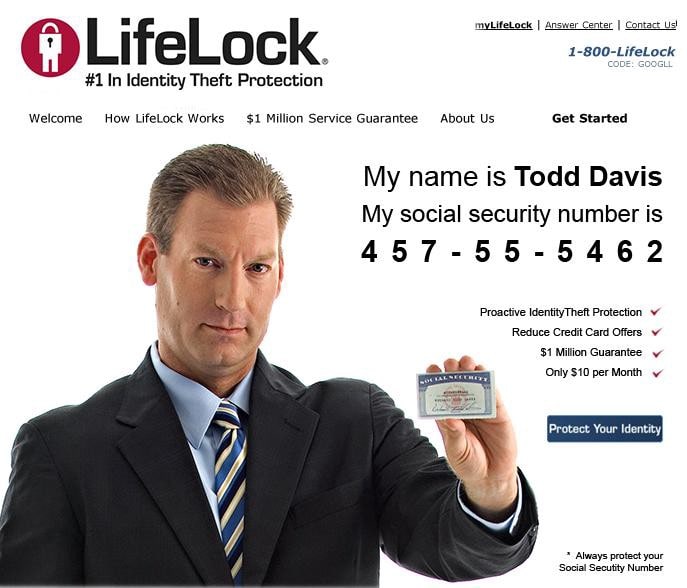
Why is LifeLock on the list of unethical ads?
Let’s first address the fact that when you have blind confidence in your product and service things can go wrong.
The message sent out in the ad was clearly deceptive. Fortunately for consumers, the company’s claims were debunked with humorous consequences. Revealing their use of false, unethical ads.
Takeaways from Lifelock’s unethical ads
We get the point of some controversial ads BUT do not blindly trust your own product when making a billboard-sized statement. Continuously test your product to ensure it is providing the value you claim to your customers.
Communicate the value of your product and service and maybe avoid lying to current and future customers.
6. Pepsi’s Bad Advertisement – Live for now – Moments
Pepsi: Pepsi fixes any problem
- Year: 2017
- Media: Television
PepsiCo has not typically been known for producing bad ads, but this one was a total misfire.
Released in 2017, the Pepsi ad made the headlines for piggybacking of the Black Lives Matter movement to promote their product.
With a can of Pepsi, model Kendall Jenner solves all of America’s social problems. That powerful sip of Pepsi puts an end to racism, police brutality, and probably some other unidentified social issues.
That’s how powerful Pepsi is. The ad was pulled by the brand after the marketing campaign was condemned for trivializing Black Lives Matter. The company later released a public apology.
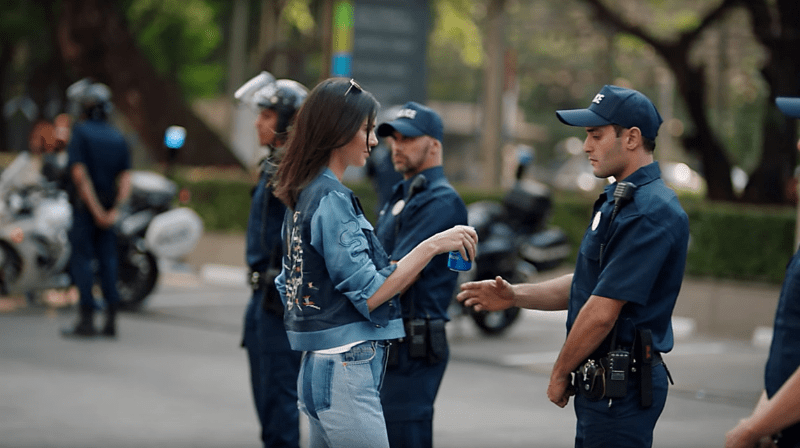
Did the Pepsi controversial ads work?
There are two ways to approach a problematic social issue. One way, which this campaign demonstrates ever so subtly, is taking advantage of the social issue to promote a product.
On the other hand, supporting a social movement with a clear message is a whole different thing. Strive for the latter if you want to avoid being publicly shamed for promoting your brand with controversial ads. Pepsi was widely discredited, hurting purchase consideration for the brand for years.
Takeaways from Pepsi’s unethical ads
Increasing sales when promoting a product is usually the end goal. In the end, throwing your reputation under the bus while you are at it is not the best idea.
Pepsi believed that capitalizing on a social movement in order to make short-term gains was more important than taking the time to think through their strategy. Not something we recommend.
7. Mastercard’s Controversial Ads – World Cup
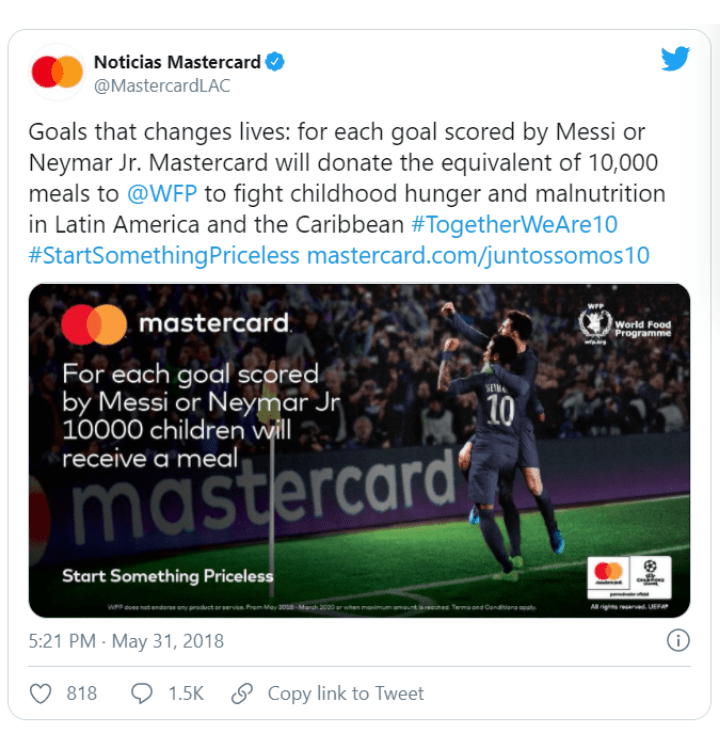
- Year: 2018
- Media: Internet
Charity or the Hunger Games?
Why is a Mastercard charity on the list of controversial ads you ask?
Mastercard made a statement during the World Cup that with every goal Lionel Messi and Neymar Jr scored, the company would donate 10,000 meals to children in Latin America and the Caribbean.
The tactic to gamify starvation was condemned by people, gaining negative attention from professionals in marketing and PR for its tone-deaf attitude.
After a while, Mastercard dropped the campaign, just as well since the two stars only scored three goals between them.

Why is Mastercard on the list of controversial ads?
The message was so incredibly twisted!
A company with double-digit revenue growth made a charity for starvation into a ‘will they, won’t they’ death trap. A lack of judgement on their behalf in an attempt to gain publicity.
C’mon, you’re already the World Cup’s largest sponsor. We see you!
Takeaways from Mastercard’s unethical ads
Social issues are a tough area. If you are taking advantage of them to promote your business, just skip it and find a better solution.
Be authentic and sincere. Your brand image, PR team, and the world will thank you.
8. Nivea – Controversial ads for White is Purity Campaign
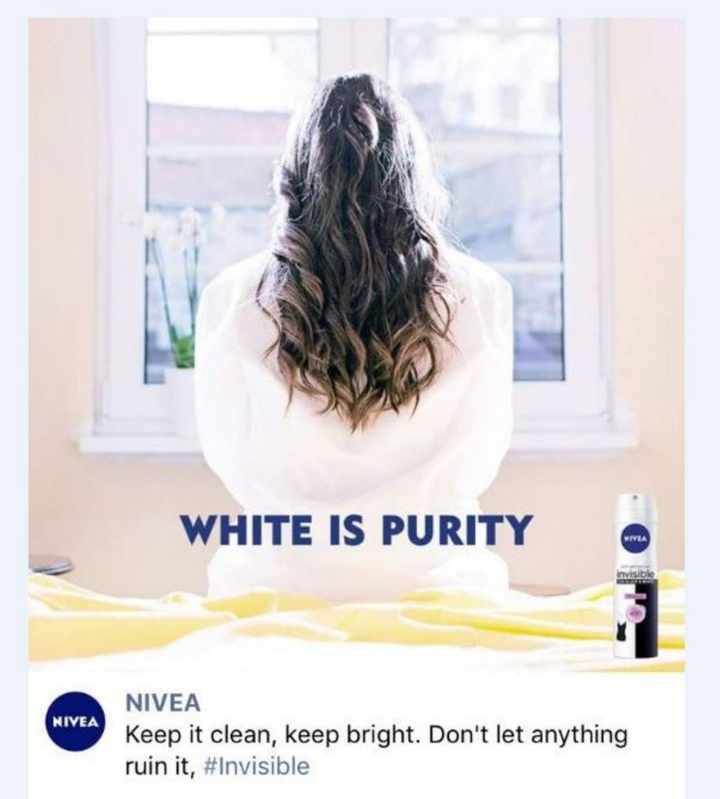
- Year: 2017
- Media: Print, Internet
“White is purity. Keep it clean, keep bright. Don’t let anything ruin it.”
If that doesn’t earn Nivea the racist ads red card, what will?
It’s hardly shocking that the only positive attention this campaign slogan only got was from the alt-right. The campaign got shared on social media with the quote “#Nivea: the official moisturizer/anti-perspirant of the #AltRight.”
Ironically, Nivea’s reputation was dragged through the dirt, and the campaign condemned by the public. Nivea pulled the plug on the controversial ad immediately.The campaign, meant for release in the Middle East, was scrapped and a pathetic apology was released by the brand claiming the bad ad was “misleading”.

What makes this ad campaign bad?
How the racist connotations failed to surface during the creative process is surprising, to say the least.
Controversial connotations like these can harm customers’ perception of your brand. For Nivea, a wholesome family-friendly product, the damage in perception was huge…
Takeaways from Nivea’s Bad Advertisement
Sensor your content and message. It’s better in the long run to scrap a questionable campaign than running a problematic campaign and having to earn back your customers’ trust.
If you operate an international business, the unethical operations of those branches can still damage your brand. No company exists in a bubble anymore. If it’s your name on the product, you own the responsibility for it.
9. Reebok’s Bad Ads – Don’t Cheat on Your Workout
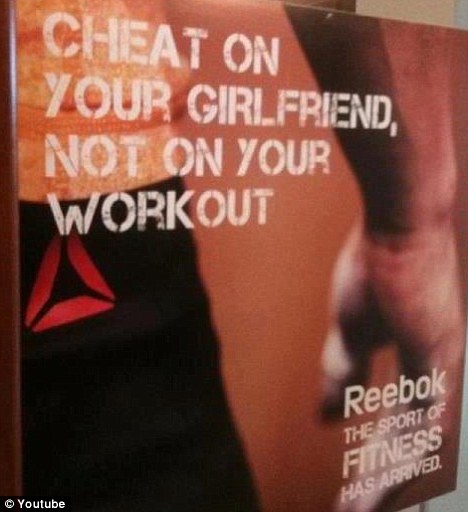
- Year: 2012
- Media: Print
“Cheat on your girlfriend, not on your workout”.
What an inspiring statement.
This series of controversial ads was only used in Germany but gained global social media attention for its repulsive message.
Compared to other sexist ads the brand’s message was the most out-there. Stated in writing, the brand could not hide behind “unfortunate” symbolism.
Social media users boycotted the brand, demanding an apology and that the campaign be pulled. Hours later Reebok did just that, apologizing for the campaign ever appearing at all.
This wasn’t the first time Reebok released a controversial ad though, the below image was released as part of a campaign for Reebok Russia. Whilst we won’t translate the crude slogan Reebok went with, you’ll have to trust us when we say it’s very, very problematic.
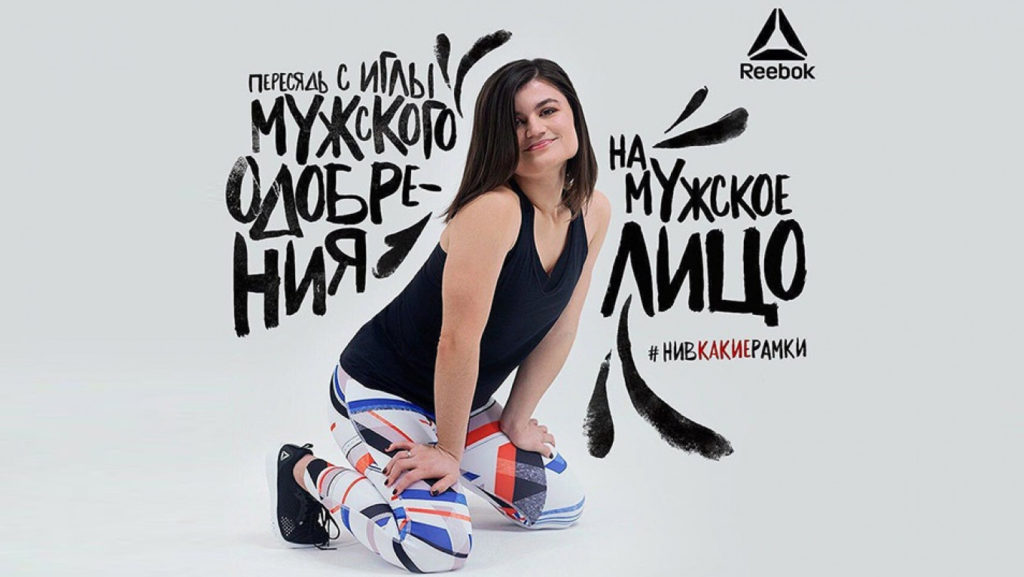
Why is Reebok on the list of sexist ads?
A brand should never give its audience bad advice. Locker room talk, boys will be boys, and all that BS does not belong in marketing (or anywhere, for that matter).
Reebok failed to realise that anyone other than misogynists would not find this ad funny.
Takeaways from Reebok’s controversial ads series
Encouraging your audience is a great way to build trust and speak to individuals. Limiting that encouragement to doing good, helping others, and staying healthy is an even better approach.
Ensuring that your messaging aligns with the values of your target customers is critical in a successful ad campaign.
10. Reese’s Pieces Bad Ads – Love Child
- Year: 2012
- Media: Television
Love Child might be one of the less controversial ads on the list, but maybe it’s more icky than anything else.
This *loses appetite* campaign is a magnificent trainwreck.
The video ad is loud, sweaty, gooey, confusing, and not appetizing at all. It is so bad that you have to watch it. Reese’s Pieces Love Child campaign was probably meant for an audience trying to quit those delicious pieces.
What makes this ad campaign bad?
As beautiful as childbirth is and as delicious as those peanut butter pieces are, the combination of the two, is just so wrong.
What was the marketing objective here? What sick mind dreamt up this twisted concept?
Takeaways from Reese’s bad advertisement
When constructing a campaign, there are a few key questions you should try to answer, who is this for? What action do I want people to take?
Learn from this example, undoubtedly the desired action was not for people to put down the product and go vomit.
[Read More about 2020 Coronavirus Ad Campaigns]
11. AXE Sexist Ads – Women are Dangerous

- Year: 2013
- Media: Television
Another award winning ‘boys will be boys’ campaign for the sexist ads category.
This time a video commercial starting with a group of men unable to stay focused on their work as beautiful women in revealing clothing surround them. As the men mindlessly stare at these women they become increasingly heated.
But don’t despair human male, AXE to the rescue.
The caption reads, “It helps guys keep their cool… before it’s too late.”
Wait, was that a threat?
As this ad falls into the banned ads category, a copy of the ad was not available. The undertones of victim-blaming are paralleled beautifully with the implication of sexual assault.
Controversial ads are nothing new for AXE, in fact, there are many examples.
Why is AXE on the list of sexist ads?
The brand uses sexist messages and stereotypes to sell its product. In fact, AXE was well-known for its tasteless marketing and unethical ads before the release of this specific ad campaign.
The number of banned ads produced by AXE is unknown, but the fact that there is more than one hints that the brand might be better off trying a different approach.
In 2017, AXE finally gave up its commitment to sexism, promoting its reformed strategy in the hopes of earning new customer segments.
Takeaways from AXE’s unethical ads
Ok, AXE loves its controversial ads BUT a brand’s reputation is its legacy.
Admitting to your mistakes and changing direction may work better than repeating the same marketing tactic over and over again, expecting different results.
That is afterall the definition of insanity.
12. Heineken’s Bad Ads – Sometimes Lighter is Better
- Year: 2018
- Media: Print and Television
In 2018 Heineken made its debut in the racist ads category.
It’s as if the marketing department at Heineken saw the high engagement rates of Nivea’s ‘White is Purity’ campaign and decided to copy their message (of course, that engagement was overwhelmingly negative).
The ad begins with a bar. The bartender notices a light-skinned lady at the end of the bar. He slides a beer her way. The beer slides past more than a few black people before finally stopping at the light-skinned lady.
Then the tagline reads, “Sometimes lighter is better”.
Seriously, who is qualifying this stuff for distribution?! For a beer that is “enjoyed in 192 countries”, you’d think they were be a little more sensitive to issues of racism.
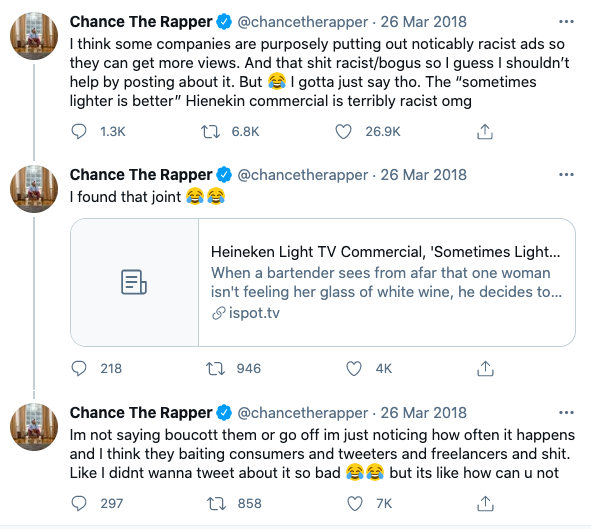
Why is it on the list of controversial ads?
For Heineken, this bad advertisement qualifies for the racist ads category, displaying clear symbolic segregatation between black and white people, including reference to race in the slogan.
Let’s get real, a message with connotations to inequality, promoting one race as “better” isn’t going to elevate your brand.
Takeaways from Heineken’s Bad Advertisement
Pay attention to signs and symbols. Semiotics in advertising focuses on the non-verbal symbols that spark emotion.
Unspoken symbolism can grab more attention than what is said. Consider what might be inferred by your ad before distributing it. Although in this case, paying attention to the written content would have been advisable too.
13. Sprite’s Bad Ads – Brutally Refreshing
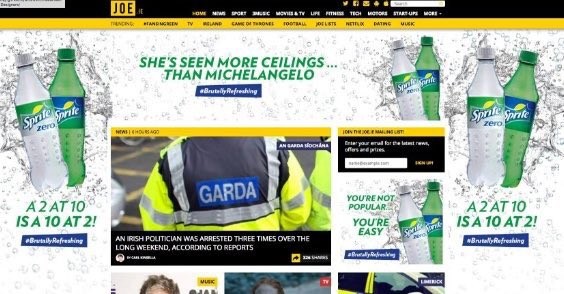
- Year: 2016
- Media: Internet
A not so #BrutallyRefreshing advertising campaign.
Some sexist ads have a clear audience or intended purpose. This one did not.
Sprite took over the Joe.ie news website with an interesting approach to selling their refreshing lemon-lime drink.
The bad banner ads displayed slogans such as “She’s seen more ceilings than Michelangelo” and “A 2 at 10 is a 10 at 2!”. What was the message for Sprite and who is the audience here? We think this guy got it right.
Coca-Cola apologised for the campaign, which was taken down due to multiple complaints of sexism and misogyny.

Why is Sprite on the list of sexist ads?
Apart from being sexist, the ad campaign was completely thoughtless. It didn’t seem to target anyone.
Where does Sprite even fit into the equation with these sexist comments?
If you are determined to sell with sex then just get to the point. “Rehydrate for round two” or even “Sex, sex, sex, Sprite” does not shame anyone.
Takeaway from Sprite’s Bad Ads
Whilst sex might still sell, it isn’t always appropriate. Regardless of the purpose of your advertisement, be sure your message is clear and targets a specific audience.
There should be more thought put into marketing than just slapping a quote or two on your website and calling it an ad campaign.
14. Haribo’s Bad Ads – Squidgy baby
- Year: 2011
- Media: Television
WTF is happening?
Is what you’ll be asking yourself after watching this bad advertisement.
A creepy family sing-along to some pretty disturbing lyrics, “Oh so smooth; love them soft; squidgy squidgy baby!”
Haribo rolled out this disaster to promote their Super Mix. The cringe-tastic ad was, thankfully, pulled shortly after its release.
What makes this ad campaign bad?
Haribo attempted a catchy jingle that would make people remember their candy, but the only memorable impression they made was a place on the bad ads list.
However, Haribo is known for campaigns focused on controversy and satire. So this campaign made them a winner in the consistency game.
Takeaways from Haribo’s bad ads
Jingles have been studied by psychologists due to their ‘stickiness’ and they can be a great way to keep your product top-of-mind. Getting consumers singing your slogan like McDonald’s did with “i’m lovin it” is a marketers dream.
Dial down the creepiness Haribo and you might have better luck with your music career.
15. The Controversial ads of Protein World – Beach Body Ready

- Year: 2015
- Media: Print
The messaging here was clear – you are not Beach Body Ready unless you look like this model whose job it is to have a perfect body.
The campaign was featured on billboards in the London Underground, before being banned by the mayor of London. A petition against the campaign quickly attracted more than 70.000 signatures, however Protein World remained unapologetic.
Applauding their own marketing team on social media, the brand stuck with the campaign.Protein World even launched a skyscraper-sized billboard in New York later that year. A gigantic “middle-finger” to the haters overseas.
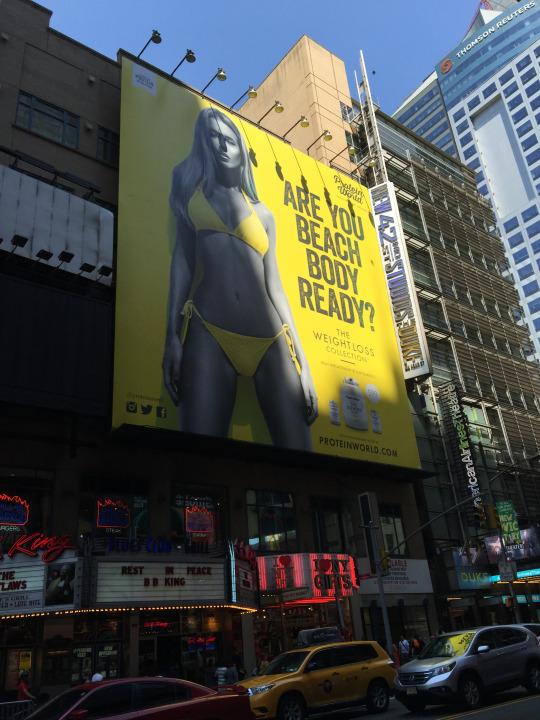
Why is it on the list of controversial ads?
The company was criticised for promoting a controversial ‘one-size-fits-all’ approach to body image, perpetuating unrealistic beauty standards. The campaign had undertones of body shaming, and was considered dangerous by many for indirectly promoting eating disorders.
Additionally, the campaign failed to deliver a meaningful message to the target audience. A good campaign will not jeopardise your brand’s integrity.
Takeaways from Protein World’s banned ads
The learning lesson here is to understand how to appeal to your audience without gambling with your reputation.
If your product relates to self-improvement, you can centre a campaign around that without implying that the audience is not good enough to begin with.
16. McDonald’s #StaySafebyStayingApart: A Failed Ad Campaign
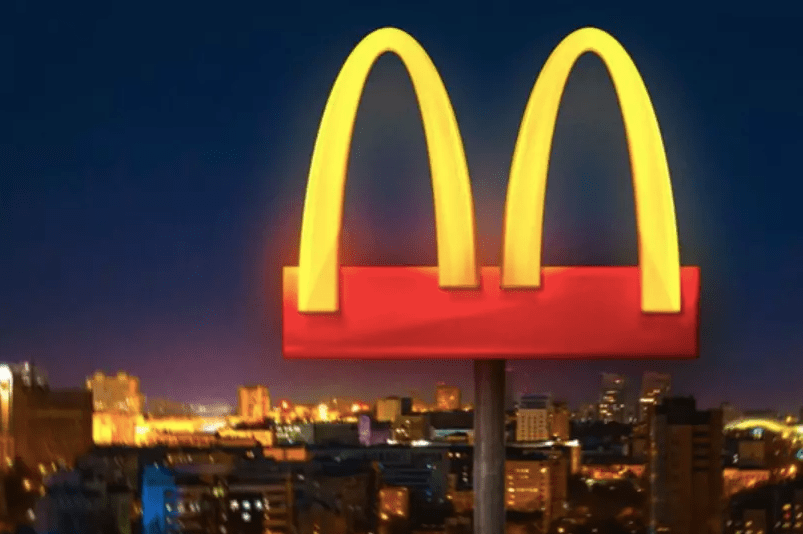
- Year: 2020
- Media: Social Media
The coronavirus pandemic has put a lot of strain people’s lives all over the world. So, McDonald’s naturally took this as an opportunity to make some money out of the situation.
In what McDonald’s claim was a show of solidarity, the company redesigned their logo, separating the iconic golden arches. The intended purpose was to promote social distancing and customer safety, allegedly.
The campaign created a Twitter storm, with users of the platform pointing out the obvious cash-grab from McDonald’s.
Following a backlash, McDonald’s removed all evidence of the campaign. This was replaced with ads for delivery services, an actual solution to the social distancing problem.
What makes this ad campaign bad?
This campaign wanted customers to believe that McDonald’s were supporting them, but it just came across as disingenuous and exploitative.
Altering the brands logo (a marketing tactic McDonald’s often employs) just appeared dismissive of the scale of the pandemic. How was this supposed to help anybody?
The tone-deaf nature of the ad didn’t encourage customers to practice social distancing, it just put more distance between the brand and its customers.
Takeaways from McDonald’s failure
If you’re a huge global corporation looking to capitalize on a pandemic, you might want to think about how you can do that whilst also helping people.
McDonald’s had the resources to genuinely help people through a really tough period. From a marketing perspective, this could have generated a strong sense of customer loyalty.
Instead, they tried the quick fix and it massively back-fired. Treat customers with respect, they’re smarter than some marketers seem to think.
17. Norwegian Cruise Lines #FeelFreetoFeelMore Campaign

- Year: 2020
- Media: Print, Social Media
If cruising used to feel like a luxury, it might seem more like a prison during the pandemic. Imagine being trapped on a cramped ship with hundreds of untested passengers and no access to medical services.
This ad encouraged customers to ‘escape it all’ with a tropical vacation at a time when everybody was supposed to be shielding to safeguard collective health. This was seen by many as an irresponsible act on the part of the company.
By conducting business as usual, NCL was putting their customers lives at risk. That’s not something we recommend if you want to have repeat business. A whistle-blower even claimed that NCL instructed sales agents to say that COVID-19 could not survive in hot weather (taking a page out of Donald Trump’s book in the process).
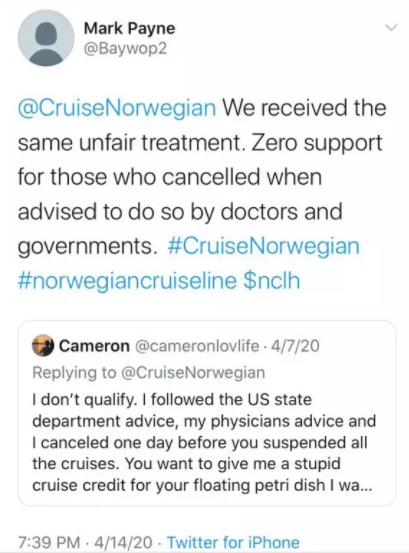
What makes this ad campaign bad?
The results of this coronavirus bad ad: Trouble in Paradise.
Frankly, the product that NCL was selling was just not what consumers wanted at the time. Instead of pretending everything was normal, NCL needed to adapt to the situation they were in.
Takeaway from Protein World’s banned ads
Customers felt that NCL acted too flippantly in the face of global health concerns. The company lost a lot of trust with its loyal customers, with the overarching sentiment that NCL simply did not care about their safety.
Never throw away your brand integrity for the sake of short-term profits unless you want to end up in the unethical ads hall of fame.
18. H&M – The Coolest Monkey in the Jungle
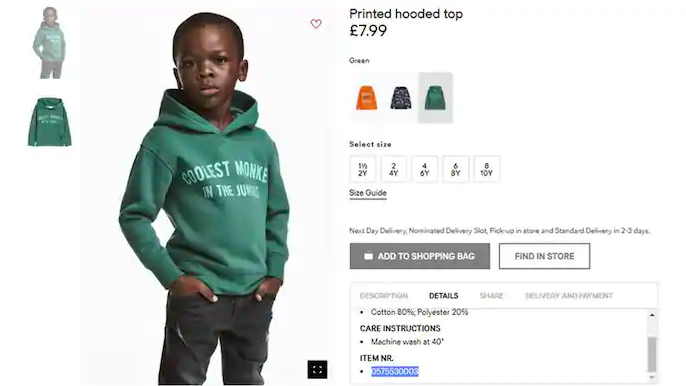
- Year: 2018
- Media: E-commerce
Another major international brand with global name recognition, another racist advertisement scandal due to a lack of consideration.
Seriously, just hire a diversity consultant, people!
In 2018, H&M released an e-commerce feature image of a young black boy wearing a hoodie with the logo “The Coolest Monkey in the Jungle”. For those who don’t know, this type of imagery has historically had very serious and hurtful racist undertones.
The apparent thoughtlessness H&M displayed caused consumers to question the diversity policies of H&M’s entire operation. Who was in the room when this image was greenlit? Are there only white people in decision-making roles at H&M?
What makes this ad campaign so controversial?
First of all, the undertones of the ad are so deeply offensive that no one should ever have seen it.
But more than that, the misfire hurt H&M’s reputation and bottom line. Many of their ambassadors cut ties with the brand, saying they did not want to be associated with racism. H&M was forced to publicly apologise.
The campaign generated a lot of awareness for the brand, but not in the way they wanted.
Takeaway from H&M’s racist ad
In a globalized society, it’s so important to be cognizant of the message your brand communicates.
Showing sensitivity to consumers from a broad range of cultural and ethnic backgrounds will pay off in the long-term.
19. RyanAir’s Fake Advertisement Mocking the Irish Government
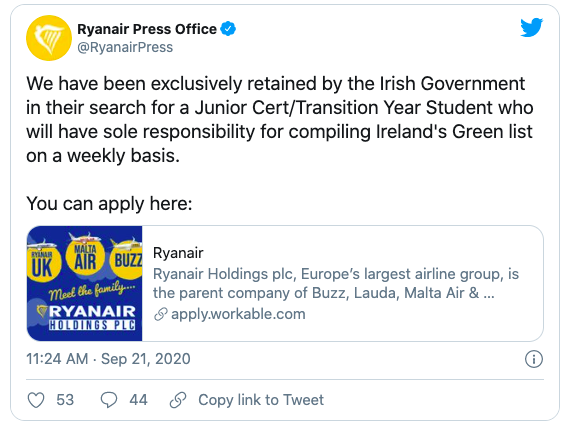
- Year: 2020
- Media: Social Media, Job Platforms
RyanAir responded to the perceived failure of the Irish government to formulate a consistent strategy on international travel during the COVID pandemic.
Hoping to publicly mock this failure, RyanAir put out a controversial ad disguised as a real job vacancy listing. The ad emphasised the lack of experience required for the job.
RyanAir had been expecting a warm reception, but the public felt very differently. They saw it as a cheap shot at a government trying to protect its citizens. The backlash across social media platforms was fierce, and RyanAir quickly removed the ad.

What makes this ad campaign bad?
At a time when societies needed to come together, RyanAir appeared intent on tearing it apart. This seemed all the more toxic to consumers given that many were still fighting battles with RyanAir to get refunds on COVID-cancelled flights.
RyanAir had been tightening its refund policy during COVID, but at times flip-flopped on this policy due to customer complaints.
The ad therefore came across as somewhat hypocritical.The bad ad campaign only furthered the perception that RyanAir was out of touch with its customer base and only interested in safeguarding its own profits.
Takeaway from RyanAir’s banned ads
They say “you shouldn’t throw stones in glass houses”, and in RyanAir’s case this is exactly what happened.
Ultimately, this ad only highlighted RyanAir’s weaknesses, which is probably the opposite of what any successful ad campaign should do.

What can you learn from these bad ads?
Whether you are new to marketing or an industry veteran, we can all learn something from these campaign ads.
The main issues we’ve identified in these controversial ads were:
- False advertisement
- Racist ads
- Exploitation of social issues
- Sexist ads
- Negative encouragement
- Unethical ads
In today’s interconnected world, brands must focus on quality assurance now more than ever. Reputational damage is no longer limited to the place or time that the controversy occurred. It lives forever on the internet.
Campaign messaging is as much subliminal as it is about what is said. Special attention should be paid to semiotics in advertising.
Your non-verbal message isn’t invisible.
But just as bad ads live forever now, so to do the best ads. Some controversial ads have changed consumer perceptions, or even entire industries.
Don’t stop making ads, just make sure you double-check them before they go live!

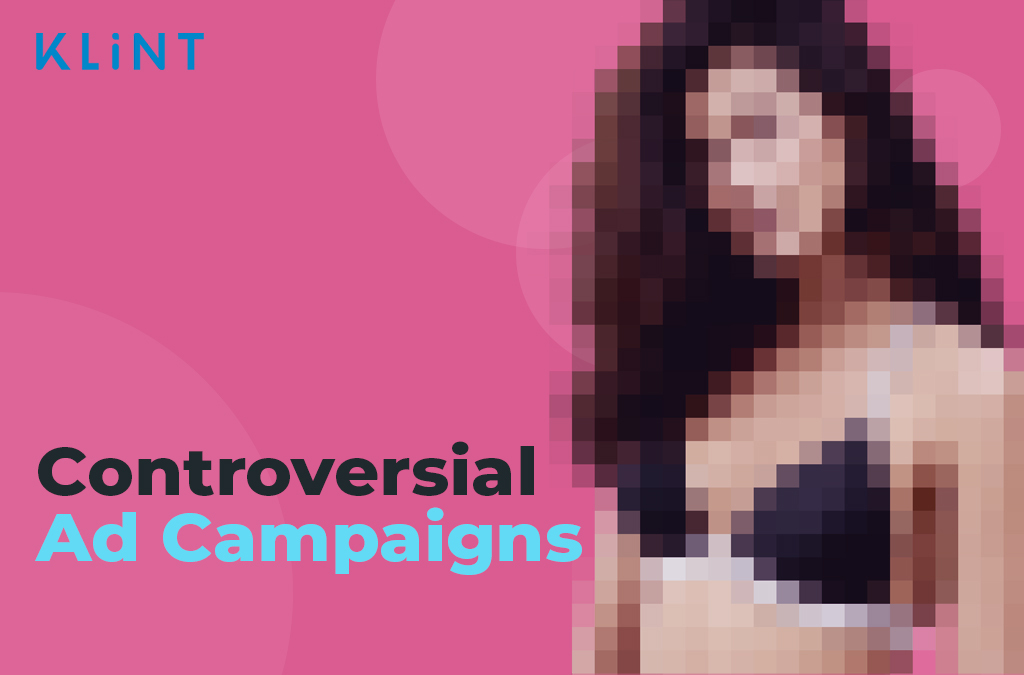
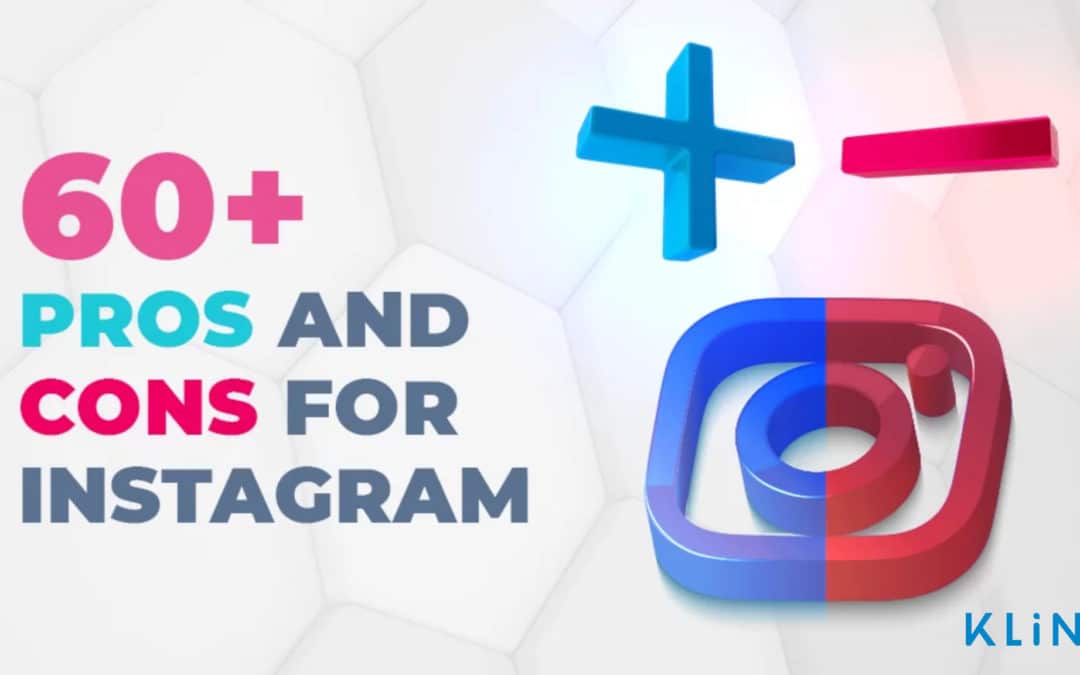
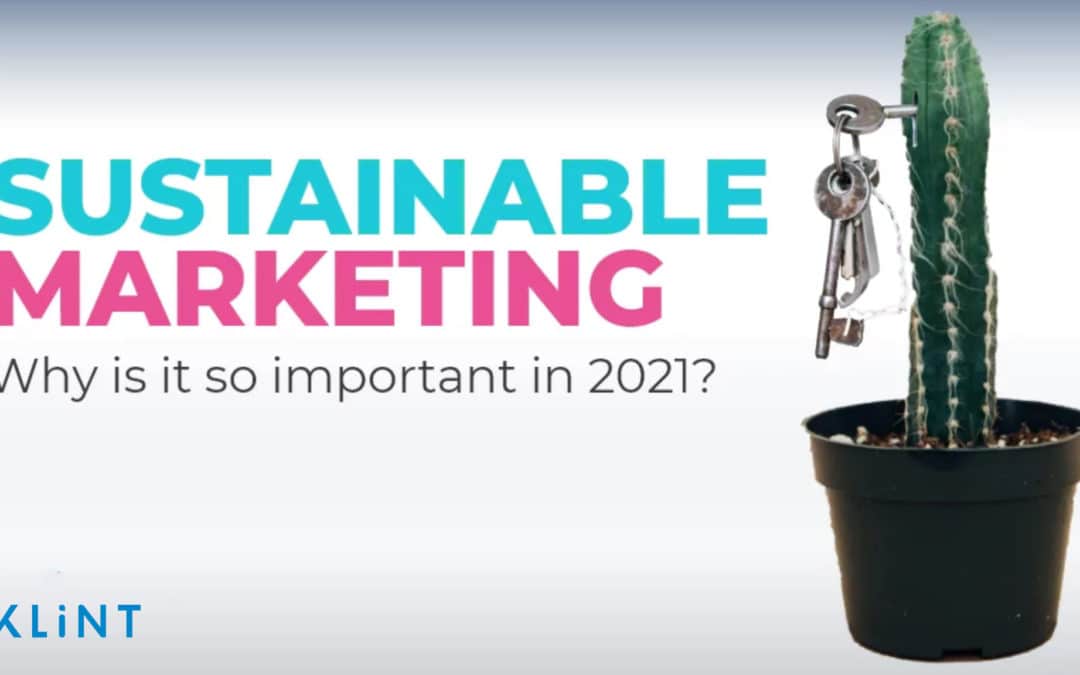

0 Comments